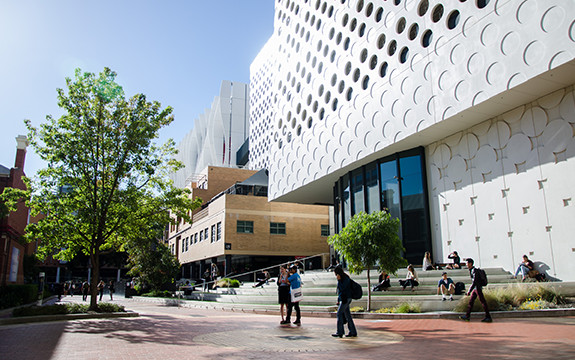HA LF’s ‘kooriography’ shines at the Wominjeka Festival

In Summary
- Analysis for The Conversation by Elizabeth Dori Tunstall, Swinburne University of Technology
As part of the this weekend, Mariaa Randall (Githatbul and Gidabul) and the Dubai Kungka Miyalk (DKM) Dance Company’s moving performance HA LF places the journey towards self-acceptance within the specific context of contemporary Indigenous Australian identity.
The journey towards self-acceptance is a universal one. First, there is a state of innocence, which is followed by an awareness of difference. Next comes an experience of external rejection, which then builds up to a climax of failed attempts at assimilation. Finally, we see self-acceptance.
Randall uses dance, video projection and soundscape to keep the focus on contemporary experiences of Indigenous Australians of diverse heritages. HA LF portrays a specific journey of self-acceptance for Australia’s Aboriginal “half-castes” in four movements: Loss, Segregation, I,dentity and Painting the Dance. Half-caste was one of the two designations, along with full-blood, applied to the Australian Aboriginal population at the 1937 Conference of State and Federal Ministers.
While the stage is still bathed in darkness, Randall appears with her back to the audience as a lithe but strong figure in a long white dress. A voice reads out the names of various Aboriginal communities. The figure moves languorously upstage, bending to caress her legs, arms and back.
Awareness of difference and loss
The darkness is pierced by the first high-definition video projection. Large heads in black and white call out racist taunts about not being black enough, white enough, or why some one would want to claim Aboriginality. Thus, the difference is named: race.
What is made clear through the diversity of the video performers is that the story being told is not just an individual’s story, but rather one of a larger community. There are a total of five video performers: Sandy Greenwood, Deon Hastie (Djabugay), Sermsah Suri Bin Saad (Nyikina), Leila Gurruwiwi (Galpu) and Maurial Spearim (Gamilaraay).
In the Loss section of HA LF, the performance splits between the dance of an Aboriginal man projected on the screen, beautifully performed by Hastie, and of Randall on the floor of the stage. Paula Van Beek’s tight lighting design ensures that you are focused only on the figures on the screen and on the floor.
With Jennifer Williams’ beautiful singing of an originally composed song in Githabul language in the background, the Aboriginal man slowly paints his body with white ochre in ceremony. In a separate dance from the one on the screen, Randall closely caresses the surfaces of her skin and rocks her body.
In my favourite moment from the performance, Randall writhes on the floor of the stage, coating her pale body and white dress in black pigment. The scene reconnected me with Randall’s riveting performance at Blak Dot Gallery as part of the 2014 Melbourne Fringe Festival, which I reviewed for The Conversation.
The program describes this section as being about a woman’s loss of partner: culture. Randall does an exceptional job of using her body movements and facial expressions to convey the woman’s grief. She should trust the communicative power of her dance more. The loud sobbing at the end of this section of the performance was not needed to express the depth of the sadness.
External rejection and Segregation
In Segregation, the scene for the journey of external rejection is set in the primary site of most identity prosecution: the school. With a quick costume change into a grey shirt and short combo with white dots, Randall transforms herself into a young child.
While being aurally assaulted by a cacophony of racial taunts, Randall’s movements imitate the writing of words. Jerky gestures that cause white dots to flutter from her body to the ground express her growing agitation. She speaks back, ending the scene with a resounding “Fuck off!”
Assimilation and I,dentity
The I,dentity section is the most literal in addressing the process of assimilation. Dressed in black – here special kudos should be given to costume designer Kelsey Henderson – Randall balances herself on “tightrope” of white powder in the centre of the floor. Her missteps and stumbles blur the boundary between the two halves. Returning to lyricism, Randall picks up handfuls of white powder and creates a trail of her own path off the stage.
In the projection, the video performers introduce themselves and their hybrid Indigenous plus European, Indonesian, Pacific Islander etc heritages.
Self-acceptance and painting the dance
The final section of the performance, Painting the Dance, demonstrates the true power of Randall’s “Kooriography”.
Self-caressing, swirling and writhing gestures that we have seen before in the performance are performed now with a sense of joy. Her body and dress coated in white powder and black pigment becomes indistinguishable from the self-created patterns of powder and pigment on the floor.
She has reached self-acceptance and we have been liberated by her journey.
HA LF is playing as part of the Footscray Community Arts Centre Wominjeka Festival until January 17. Details here
Written by Elizabeth Dori Tunstall, Swinburne University of Technology. This article was originally published on The Conversation. Read the original article.

